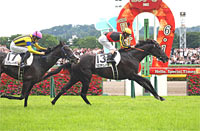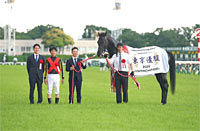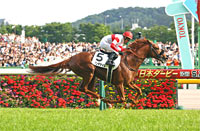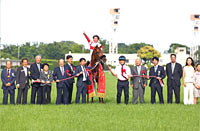Tokyo Yushun (Japanese Derby) (G1) - Data Analysis
Ultimate contest for three-year-olds
The Tokyo Yushun (Japanese Derby) is the ultimate contest for thoroughbred horses born in 2017. Up to 18 runners can enter the race, and participation in the race is itself regarded as a great honor. All runners and horsemen dream of taking home the Japanese Derby title. Many horse racing fans also eagerly await the outcome of the race. So, what kind of race can we expect this year? Let’s have a look at the results for the last 10 years.
Check performance by bracket number
Over the last 10 years, the Japanese Derby has been contested by 18 runners every year except in 2010 and 2014, when the field was reduced to 17 runners due to dropouts. When looking at performances by runners in terms of bracket number, we find that runners starting in Bracket 1 produced four winners and two runners-up, reflecting strong performance. The high Win ratio for runners starting in Bracket 1 stands out because no other bracket numbers were tied to multiple winners. In addition, runners starting in Bracket 4 produced three runners-up and three third-place finishers but zero winners. [Table 1]
[Table 1] Performance by bracket number (last 10 years)
| Bracket number |
Performance
[1st-2nd-3rd-4th or lower] |
Win ratio |
Top 2 ratio |
Top 3 ratio |
| 1 |
4-2-1-13 |
20.0% |
30.0% |
35.0% |
| 2 |
1-1-2-16 |
5.0% |
10.0% |
20.0% |
| 3 |
1-0-0-19 |
5.0% |
5.0% |
5.0% |
| 4 |
0-3-3-13 |
0% |
15.8% |
31.6% |
| 5 |
1-1-0-18 |
5.0% |
10.0% |
10.0% |
| 6 |
1-2-1-16 |
5.0% |
15.0% |
20.0% |
| 7 |
1-1-2-26 |
3.3% |
6.7% |
13.3% |
| 8 |
1-0-1-27 |
3.4% |
3.4% |
6.9% |
Watch performance by win odds
Of the last 10 winners, seven were backed by win odds of below 10. However, runners backed by win odds of “2.9 or lower” had a lower Top 3 ratio than those backed by win odds of “3.0-4.9” and “5.0-6.9,” reflecting somewhat subdued performance. Looking at performance by favoritism, we observe that runners backed as 1st and 3rd favorite had a Top 3 ratio of 70.0%, but runners backed as 2nd favorite have typically struggled, which is an interesting statistic. [Table 2] [Table 3]
[Table 2] Performance by win odds (last 10 years)
| Win odds |
Performance
[1st-2nd-3rd-4th or lower] |
Win ratio |
Top 2 ratio |
Top 3 ratio |
| 2.9 or lower |
2-1-1-4 |
25.0% |
37.5% |
50.0% |
| 3.0-4.9 |
2-2-3-5 |
16.7% |
33.3% |
58.3% |
| 5.0-6.9 |
2-2-1-3 |
25.0% |
50.0% |
62.5% |
| 7.0-9.9 |
1-0-0-7 |
12.5% |
12.5% |
12.5% |
| 10.0-19.9 |
1-4-2-15 |
4.5% |
22.7% |
31.8% |
| 20.0-49.9 |
1-1-0-28 |
3.3% |
6.7% |
6.7% |
| 50.0-99.9 |
1-0-1-29 |
3.2% |
3.2% |
6.5% |
| 100 or higher |
0-0-2-57 |
0% |
0% |
3.4% |
[Table 3] Performance by favoritism (last 10 years)
| Favoritism |
Performance
[1st-2nd-3rd-4th or lower] |
Win ratio |
Top 2 ratio |
Top 3 ratio |
| 1st favorite |
3-1-3-3 |
30.0% |
40.0% |
70.0% |
| 2nd favorite |
1-1-1-7 |
10.0% |
20.0% |
30.0% |
| 3rd favorite |
3-3-1-3 |
30.0% |
60.0% |
70.0% |
| 4th favorite |
0-1-0-9 |
0% |
10.0% |
10.0% |
| 5th favorite |
1-3-0-6 |
10.0% |
40.0% |
40.0% |
| 6th-10th favorite |
1-1-3-45 |
2.0% |
4.0% |
10.0% |
| 11th favorite or lower |
1-0-2-75 |
1.3% |
1.3% |
3.8% |
Focus on runners coming from Satsuki Sho
Looking at performances by runners in terms of the previous race, we observe that 20 of the 30 Top 3 finishers over the last 10 years had contested the Satsuki Sho (Japanese 2000 Guineas) last time out. Runners coming from the Kyoto Shimbun Hai produced the second largest number of Top 3 finishers, and runners coming from the TV Tokyo Hai Aoba Sho trial race, which is held at the same racecourse as the Japanese Derby, produced two runners-up but zero winners. [Table 4]
[Table 4] Performance by previous race (last 10 years)
| Previous race |
Performance
[1st-2nd-3rd-4th or lower] |
Win ratio |
Top 2 ratio |
Top 3 ratio |
Satsuki Sho
(Japanese 2000 Guineas) |
8-7-5-66 |
9.3% |
17.4% |
23.3% |
| Kyoto Shimbun Hai |
2-1-1-22 |
7.7% |
11.5% |
15.4% |
TV Tokyo Hai
Aoba Sho |
0-2-3-20 |
0% |
8.0% |
20.0% |
| Principal Stakes |
0-0-1-8 |
0% |
0% |
11.1% |
| Other race |
0-0-0-32 |
0% |
0% |
0% |
Looking at performances by runners that had contested the Satsuki Sho last time out in terms of favoritism in that race, we find that runners backed as “3rd favorite to 5th favorite” produced the highest number of winners. The only runner that had been backed as 1st favorite in the Satsuki Sho before winning the Japanese Derby was Wagnerian in 2018. [Table 5]
[Table 5] Among runners that had contested the Satsuki Sho last time out, performance by favoritism in that race (last 10 years)
| Favoritism in previous race |
Performance
[1st-2nd-3rd-4th or lower] |
Win ratio |
Top 2 ratio |
Top 3 ratio |
| 1st favorite |
1-1-2-5 |
11.1% |
22.2% |
44.4% |
| 2nd favorite |
0-4-0-5 |
0% |
44.4% |
44.4% |
| 3rd favorite |
3-1-1-5 |
30.0% |
40.0% |
50.0% |
| 4th, 5th favorite |
3-0-1-7 |
27.3% |
27.3% |
36.4% |
| 6th favorite or lower |
1-1-1-44 |
2.1% |
4.3% |
6.4% |
Strong record in JRA graded races is also key
Looking at performances by runners over the last 10 years in terms of win experience in JRA graded races for two-year-olds and three-year-olds, 10 runners had “won a graded race at the age of 2 and 3,” but the runners in this group produced zero winners and only one runner-up: Isla Bonita in 2014. Many of the Top 3 finishers had “only won a graded race at the age of 2” or “only won a graded race at the age of 3,” with the latter group making up over half of the Top 3 finishers (16 of 30 runners). Runners that had “never won a graded race” had a lackluster Top 3 ratio of 6.6%, although they delivered the winner (Roger Barows) and third-place finisher (Velox) of last year’s race. [Table 6]
[Table 6] Performance by win experience in JRA graded race at age 2 or 3 (last 10 years)
| Win experience |
Performance
[1st-2nd-3rd-4th or lower] |
Win ratio |
Top 2 ratio |
Top 3 ratio |
Won a graded race at the
age of 2 and 3 |
0-1-2-7 |
0% |
10.0% |
30.0% |
Only won a graded race at
the age of 2 |
4-2-0-21 |
14.8% |
22.2% |
22.2% |
Only won a graded race at
the age of 3 |
5-7-4-49 |
7.7% |
18.5% |
24.6% |
| Never won a graded race |
1-0-4-71 |
1.3% |
1.3% |
6.6% |
Horses with a change of jockey fare poorly
The last 10 winners of the Japanese Derby all contested the race with the “same jockey as the previous race.” If we go further back in time, we find that horses with a “different jockey from the previous race” have consistently fared poorly, with 1985 winner Sirius Symboli being the last horse to win the race with a different jockey from the previous race. [Table 7]
[Table 7] Performance by jockey (last 10 years)
| Jockey |
Performance
[1st-2nd-3rd-4th or lower] |
Win ratio |
Top 2 ratio |
Top 3 ratio |
| Same jockey as previous race |
10-8-7-93 |
8.5% |
15.3% |
21.2% |
Different jockey from
previous race |
0-2-3-55 |
0% |
3.3% |
8.3% |
Seek out the winner!
Watch performance in third last race
All Japanese Derby winners since 2015 had “won their third last race while backed as 1st favorite.” Incidentally, only four of the runners in last year’s race met this condition. [Table 8]
[Table 8] Five last winners’ favoritism and finish in third last race
| Year |
Winner |
Favoritism and finish in third last race |
| 2015 |
Duramente |
Saintpaulia Sho |
1st favorite |
1st |
| 2016 |
Makahiki |
Wakagoma Stakes |
1st favorite |
1st |
| 2017 |
Rey de Oro |
Habotan Sho |
1st favorite |
1st |
| 2018 |
Wagnerian |
Tokyo Sports Hai Nisai Stakes |
1st favorite |
1st |
| 2019 |
Roger Barows |
Fukujuso Tokubetsu |
1st favorite |
1st |
(Yasunori Asano)
|




















